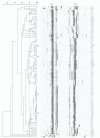Phenotypic and Genotypic Characterization of Staphylococcus aureus Strains from Italian Dairy Products
- PMID: 20148086
- PMCID: PMC2817871
- DOI: 10.1155/2009/501362
Phenotypic and Genotypic Characterization of Staphylococcus aureus Strains from Italian Dairy Products
Abstract
Staphylococcus aureus is a known major cause of foodborne illnesses, and milk and dairy products are often contaminated by enterotoxigenic strains of this bacterium. In the present study, 122 S. aureus isolates collected from different dairy products were characterised by phenotypic properties, by the distribution of genes encoding staphylococcal enterotoxins (sea, sec, sed, seg, seh, sei, sej, and sel) and by randomly amplified polymorphic DNA PCR (RAPD-PCR). Moreover, strain resistance to vancomycin and methicillin (oxacillin) was studied. The differences in the RAPD-PCR profiles obtained with the primers M13 and AP4 revealed the presence of a great genetic heterogeneity among the different S. aureus strains. Using the primer AP4 and M13, eight groups were distinguished by RAPD-PCR cluster analysis, although, except in few cases, it was not possible to correlate the isolates of different animal species (cow or ovine) with the presence of se genes. None of the isolates showed resistance to vancomycin or methicillin.
Figures
Similar articles
-
Enterotoxin gene profiles of Staphylococcus aureus isolated from milk and dairy products in Italy.Lett Appl Microbiol. 2014 Feb;58(2):190-6. doi: 10.1111/lam.12182. Epub 2013 Nov 14. Lett Appl Microbiol. 2014. PMID: 24151939
-
Prevalence of staphylococcal enterotoxins, toxin genes and genetic-relatedness of foodborne Staphylococcus aureus strains isolated in the Marmara Region of Turkey.Int J Food Microbiol. 2011 Aug 2;148(2):99-106. doi: 10.1016/j.ijfoodmicro.2011.05.007. Epub 2011 May 14. Int J Food Microbiol. 2011. PMID: 21652103
-
Detection of classical enterotoxins and identification of enterotoxin genes in Staphylococcus aureus from milk and dairy products.Vet Microbiol. 2007 Sep 20;124(1-2):66-72. doi: 10.1016/j.vetmic.2007.03.014. Epub 2007 Mar 27. Vet Microbiol. 2007. PMID: 17462836
-
Molecular characterization of enterotoxigenic and borderline oxacillin resistant Staphylococcus strains from ovine milk.Food Microbiol. 2012 Dec;32(2):265-73. doi: 10.1016/j.fm.2012.06.009. Epub 2012 Jul 16. Food Microbiol. 2012. PMID: 22986189
-
Characterization of Staphylococcus aureus strains isolated from bovine milk in Hungary.Int J Food Microbiol. 2007 Sep 15;118(2):186-93. doi: 10.1016/j.ijfoodmicro.2007.07.010. Epub 2007 Jul 21. Int J Food Microbiol. 2007. PMID: 17727995
Cited by
-
Occurrence and Characteristics of Staphylococcus aureus in a Hungarian Dairy Farm during a Control Program.Pathogens. 2021 Jan 21;10(2):104. doi: 10.3390/pathogens10020104. Pathogens. 2021. PMID: 33494548 Free PMC article.
-
Molecular Epidemiology of Methicillin-Resistant and Methicillin-Susceptible Staphylococcus aureus in the Ovine Dairy Chain and in Farm-Related Humans.Toxins (Basel). 2017 May 16;9(5):161. doi: 10.3390/toxins9050161. Toxins (Basel). 2017. PMID: 28509842 Free PMC article.
-
Genetic characterization of antibiotic-resistant Staphylococcus aureus from milk in the North-West Province, South Africa.Saudi J Biol Sci. 2018 Nov;25(7):1348-1355. doi: 10.1016/j.sjbs.2015.10.011. Epub 2015 Oct 23. Saudi J Biol Sci. 2018. PMID: 30505180 Free PMC article.
-
Characterization of multiple antibiotic resistant clinical strains of Staphylococcus isolated from pregnant women vagina.Folia Microbiol (Praha). 2018 Sep;63(5):607-617. doi: 10.1007/s12223-018-0593-4. Epub 2018 Mar 29. Folia Microbiol (Praha). 2018. PMID: 29594949
-
Prevalence of enterotoxigenic Staphylococcus aureus in organic milk and cheese in Tabriz, Iran.Iran J Microbiol. 2014 Oct;6(5):345-9. Iran J Microbiol. 2014. PMID: 25848526 Free PMC article.
References
-
- Boerema JA, Clemens R, Brightwell G. Evaluation of molecular methods to determine enterotoxingenic status and molecular genotype of bovine, ovine, human and food isolates of Staphylococcus aureus . International Journal of Food Microbiology. 2006;107:192–201. - PubMed
-
- Balaban N, Rasooly A. Staphylococcal enterotoxins. International Journal of Food Microbiology. 2000;61(1):1–10. - PubMed
-
- Letertre C, Perelle S, Dilasser F, Fach P. Identification of a new putative enterotoxin SEU encoded by the egc cluster of Staphylococcus aureus . Journal of Applied Microbiology. 2003;95(1):38–43. - PubMed
-
- Becker K, Friedrich AW, Peters G, von Eiff C. Systematic survey on the prevalence of genes coding for staphylococcal enterotoxins SElM, SElO, and SElN. Molecular Nutrition and Food Research. 2004;48(7):488–495. - PubMed
-
- Chiang Y-C, Chang L-T, Lin C-W, Yang C-Y, Tsen H-Y. PCR primers for the detection of staphylococcal enterotoxins K, L, and M and survey of staphylococcal enterotoxin types in Staphylococcus aureus isolates from food poisoning cases in Taiwan. Journal of Food Protection. 2006;69(5):1072–1079. - PubMed
LinkOut - more resources
Full Text Sources
Molecular Biology Databases


